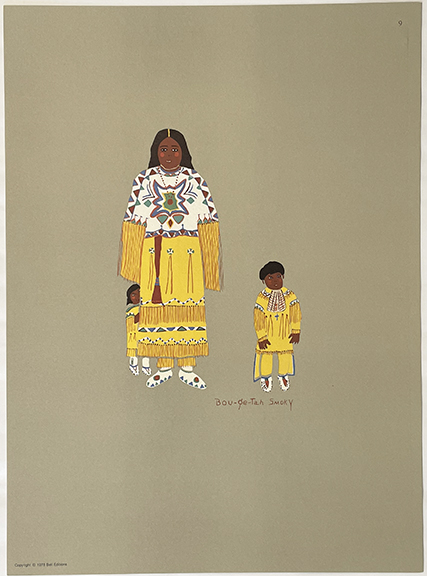
Bougetah Smoky, Kiowa Family
Lois Smoky
1907-1981
Kiowa
Alternative Name
Lois Bougetah Smoky
Date
1979
Medium Specific
Six-color Lithograph
Edition / State
Plate 9, Portfolio 128/750
Publisher
Bell Editions, Inc., Santa Fe, NM
Classification
Print
Dimensions
15 x 11 in. (38.1 x 27.9 cm)
Accession Number
2021.10.20.14
Memo / Artist Statement
From the portfolio "Kiowa Indian Art: Watercolor Paintings in Color by the Indians of Oklahoma", featuring 30 prints by a group of artists known as the Kiowa Five.The original portfolio was published by l'Edition d'Art, C. Szwedzicki in 1929 with Pochoir prints. The 1979 edition was published by Bell Editions, Inc. as lithograph reproductions that were created from #89/750 of the original 1929 edition. It also includes an introduction by Jamake Highwater, who also signed and numbered the booklet.
Biography
Kiowa artist Lois Smoky (Bougetah, Of The Dawn), was born in western Oklahoma near Anadarko in 1907. Her father, Enoch Smoky, was a great-nephew of Chief Appiatan. She attended Indian schools and in 1927 studied painting with a small group of Kiowa men at the University of Oklahoma. Smoky credited her artistic discovery to Kiowa Field Matron Susie Peters, Father Aloysius Hitta, Sister Mary Olivia, and Sister Deo Gratias of St. Patrick's Mission School, where Smoky was a student. She also praised her art teacher, Mrs. Willie Baze Lane, an art instructor living in Chickasha, Oklahoma. Accompanied by her mother, Smoky stayed only through 1927 at the university, and when she left, James Auchiah took her place in the group.
Smoky's participation in the Kiowa Five marked the first time in Oklahoma Indian history that a female had studied painting and composed and painted the human figure. Traditionally, women had only painted geometric figures. Because she was the first Indian woman in Oklahoma to step outside of the accepted role of women to paint subjects heretofore exclusive to Plains Indian men, she served as a model to later generations of Indian women artists who wished to do the same.
The Kiowa Five included six artists: Spencer Asah, James Auchiah, Jack Hokeah, Stephen Mopope, Lois Smoky, and Monroe Tsatoke. In 1927 Asah, Hokeah, Tsatoke, Mopope, and Smoky moved to Norman, Oklahoma and began their art studies at OU. Smoky returned home later in the year, and Auchiah joined the group.
In the 1928, the Kiowa Five debuted in the international fine arts world by participating in the First International Art Exposition in Prague, Czechoslovakia. Dr. Jacobson arranged for their work to be shown in several other countries and for Kiowa Art, a portfolio of pochoir prints artists' paintings to be published in France.
Her images, very similar to those created by Kiowa men, also celebrated the culture and the people. She presented Indian women in traditional Kiowa women's buckskin dresses, and sometimes with children. She, like the men who painted, used a flat, two-dimensional approach with no background or foreground. Although her interest in painting continued, her life revolved around her marriage and the raising of her children. Smoky also did intricate beadwork that was reflective of tradition designs and colors.
https://www.okhistory.org/publications
Janet Berlo, "The Szwedzicki Portfolios of American Indian Art, 1929-1952: Kiowa Indian Art, Pueblo Indian Painting & Pueblo Indian Pottery", American Indian Art Magazine, Spring, 2009: 36-45.
Olivia Von Gries, "Lois Smoky" in Kiowa Agency: Stories of Six, Fred Jones Jr. Museum of Art, Oklahoma University, 2020: 26-31.
Smoky's participation in the Kiowa Five marked the first time in Oklahoma Indian history that a female had studied painting and composed and painted the human figure. Traditionally, women had only painted geometric figures. Because she was the first Indian woman in Oklahoma to step outside of the accepted role of women to paint subjects heretofore exclusive to Plains Indian men, she served as a model to later generations of Indian women artists who wished to do the same.
The Kiowa Five included six artists: Spencer Asah, James Auchiah, Jack Hokeah, Stephen Mopope, Lois Smoky, and Monroe Tsatoke. In 1927 Asah, Hokeah, Tsatoke, Mopope, and Smoky moved to Norman, Oklahoma and began their art studies at OU. Smoky returned home later in the year, and Auchiah joined the group.
In the 1928, the Kiowa Five debuted in the international fine arts world by participating in the First International Art Exposition in Prague, Czechoslovakia. Dr. Jacobson arranged for their work to be shown in several other countries and for Kiowa Art, a portfolio of pochoir prints artists' paintings to be published in France.
Her images, very similar to those created by Kiowa men, also celebrated the culture and the people. She presented Indian women in traditional Kiowa women's buckskin dresses, and sometimes with children. She, like the men who painted, used a flat, two-dimensional approach with no background or foreground. Although her interest in painting continued, her life revolved around her marriage and the raising of her children. Smoky also did intricate beadwork that was reflective of tradition designs and colors.
https://www.okhistory.org/publications
Janet Berlo, "The Szwedzicki Portfolios of American Indian Art, 1929-1952: Kiowa Indian Art, Pueblo Indian Painting & Pueblo Indian Pottery", American Indian Art Magazine, Spring, 2009: 36-45.
Olivia Von Gries, "Lois Smoky" in Kiowa Agency: Stories of Six, Fred Jones Jr. Museum of Art, Oklahoma University, 2020: 26-31.
Date of Bio
